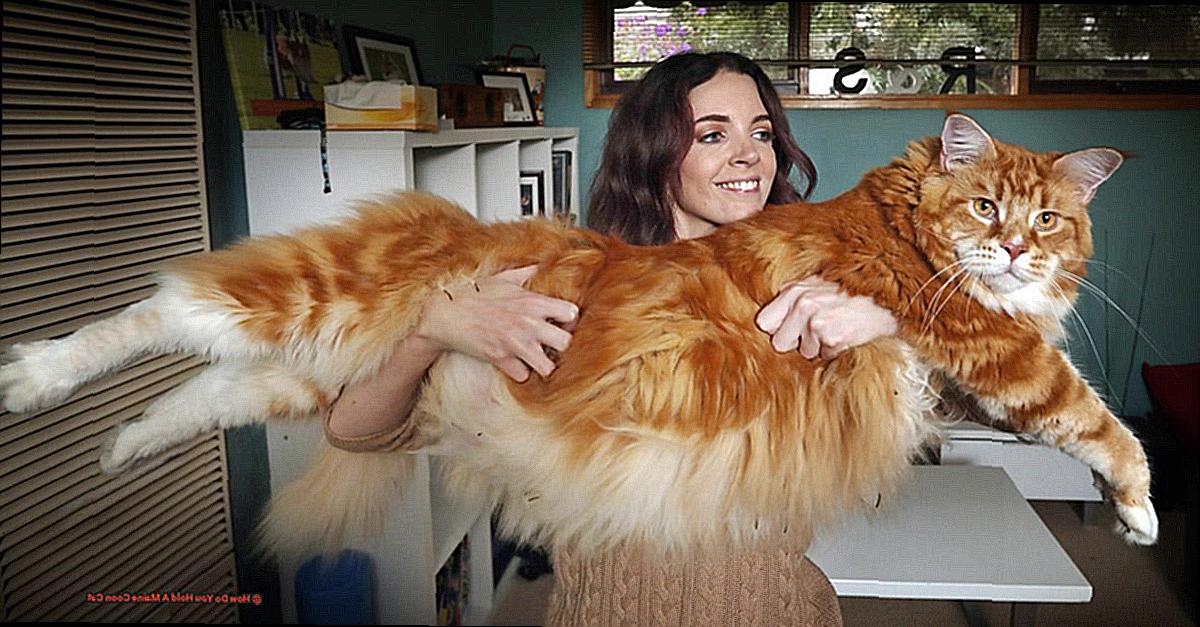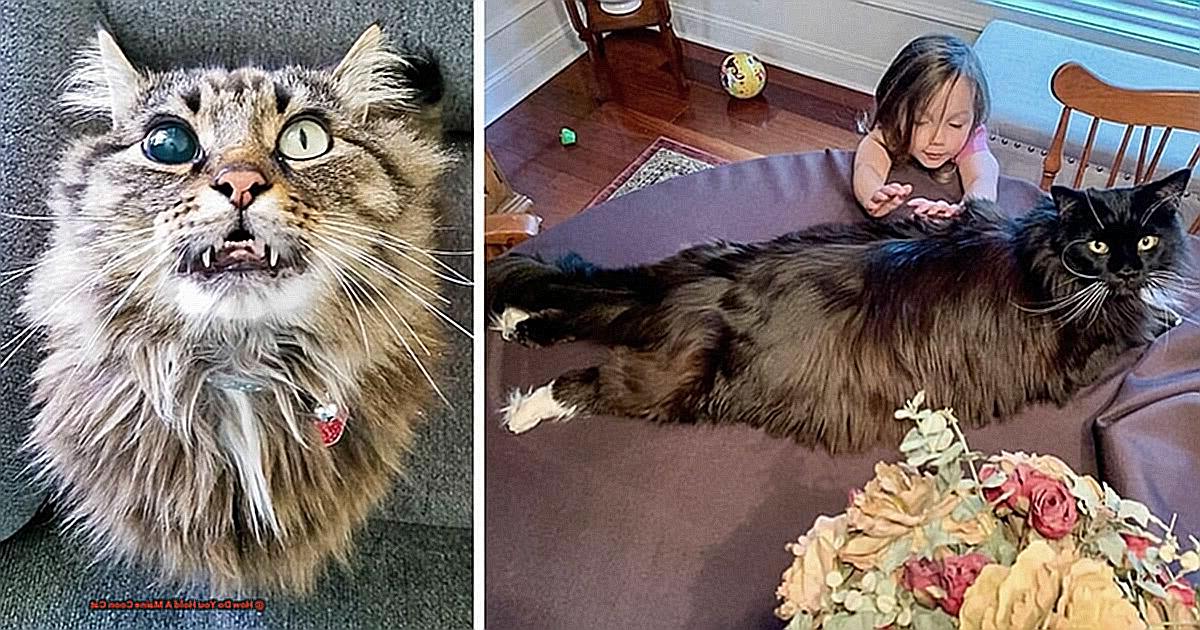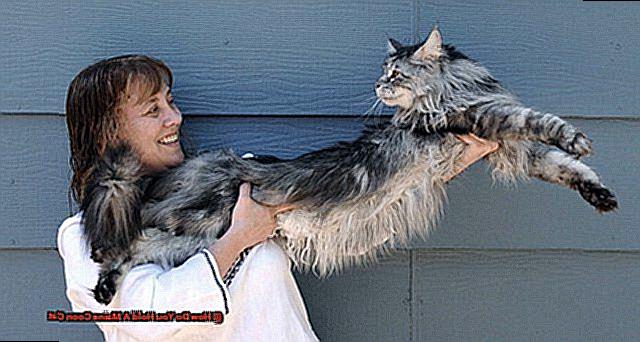Welcome to a purr-fectly delightful discussion on the art of holding a Maine Coon cat. If you’ve ever had the pleasure of encountering these majestic gentle giants, you know that cradling them with finesse is no ordinary task. With their mesmerizing emerald eyes and luxurious whiskers, Maine Coons exude an enchanting aura that demands our utmost respect and admiration.
In this blog post, we’re diving headfirst into the captivating world of Maine Coon handling. We’ll be sharing invaluable insights and practical tips to ensure a safe and comfortable experience for both you and your feline companion. Whether you’re a seasoned cat whisperer or a proud new owner of a Maine Coon, join us as we uncover the secrets to embracing these remarkable creatures in a way that truly speaks to their unique needs and personality.
So get ready for an adventure filled with warmth, affection, and unforgettable bonds as we explore the do’s and don’ts, subtle techniques, and rewarding moments that come with skillfully cradling these magnificent felines in your arms.
Let’s embark on this journey together as we unlock the secrets behind holding a Maine Coon cat like a pro.
How do you hold a Maine Coon cat
Maine Coon cats are not only known for their stunning looks and large size, but also for their gentle and sociable nature. If you’re lucky enough to have one of these majestic felines as a companion, knowing how to hold them properly is essential for their comfort and your bonding experience. In this guide, we’ll explore the best techniques and tips to ensure you’re holding your Maine Coon cat like a pro.
Approach with Confidence:
Approaching your Maine Coon cat with confidence is key to establishing trust and a sense of security. Speak softly and move slowly to avoid startling them. Remember, these cats are generally sociable, but sudden movements can make them wary.
Support Their Body:
Due to their larger size, proper support is crucial when holding a Maine Coon cat. Place one hand under their chest, just behind their front legs, and use the other hand to support their hindquarters. This will distribute their weight evenly and prevent any discomfort or strain on their body.
Secure Grip, Gentle Hold:
Once you have positioned your hands correctly, gently lift your Maine Coon cat off the ground. Ensure your grip is secure but not too tight, allowing them some freedom of movement while feeling safe in your arms. Avoid any restraining or squeezing that may cause stress or discomfort.
Pay Attention to Body Language:
While holding your Maine Coon cat, be attentive to their body language. If they display signs of distress or discomfort, such as twitching tail or flattened ears, it’s best to gently place them back on the ground. Each cat has its own comfort level when it comes to being held, so respect their boundaries.
Gradually Increase Holding Time:
If your Maine Coon cat is not accustomed to being held, introduce the experience gradually. Start with short holding sessions and gradually increase the duration as they become more comfortable. This will help them build trust and associate being held with positive experiences.
Cater to Their Preferences:
Each Maine Coon cat has its own unique personality and preferences. Some may enjoy being cradled in your arms, while others may prefer sitting on your shoulder or lap. Observe their reactions and adjust your holding technique accordingly to cater to their comfort and preferences.
Why is it Important to Hold a Maine Coon Cat Properly?
These majestic felines, known for their large size and weight, require special attention when it comes to handling. By holding them correctly, we ensure their safety, prevent injuries, establish trust, and deepen our bond with these gentle giants.
Ensuring Safety for Both Cat and Human
- Maine Coon cats are larger than your average feline, weighing up to 18 pounds for males and 12 pounds for females. Holding them improperly can lead to scratches, bites, or accidental dropping, resulting in serious injuries.
- Properly supporting their body helps distribute their weight evenly, reducing strain on their joints and muscles.
- Remember the old saying “An ounce of prevention is worth a pound of cure” – hold them right to avoid mishaps.
Building Trust and Strengthening Bonds
- Cats are naturally cautious creatures. Holding them in a secure and comfortable manner helps them feel at ease.
- By fostering positive experiences through proper handling, we strengthen the bond between ourselves and our Maine Coon companions.
- The more trust we earn, the easier and more enjoyable future interactions become.
Facilitating Grooming and Veterinary Care
- Holding a Maine Coon cat correctly provides better control during grooming sessions or veterinary visits.
- Supporting their body properly allows for easy examination of any signs of illness or discomfort.
- Brushing their luxurious fur or trimming their nails becomes a breeze when they are held securely.

Minimizing Stress and Discomfort
- Cats are sensitive creatures. Incorrect handling can cause fear or anxiety.
- By holding a Maine Coon cat properly, we provide a sense of security and minimize any potential distress.
- Remember, a happy cat means a happy life.

Supporting Their Weight When Holding a Maine Coon Cat

In this guide, we will explore the best techniques and tips for ensuring the comfort and safety of both you and your Maine Coon cat.
Using Both Hands:
When picking up a Maine Coon cat, always use both hands to support their body. This provides stability and helps distribute their weight evenly. Place one hand under their chest and the other hand under their hindquarters.
Hand Placement:
The hand supporting the chest should be positioned just behind the front legs, allowing you to have a firm grip on the cat’s body. Make sure not to apply excessive pressure or squeeze too tightly. The other hand supporting the hindquarters should be positioned towards the base of the tail, offering additional stability.
Gentle Yet Secure Grip:
Maintain a gentle yet secure grip when holding your Maine Coon cat. This will make them feel safe and supported, preventing any discomfort or potential injury. Avoid jostling or swinging them around, as this can cause stress.
Respect Your Cat’s Boundaries:
Not all Maine Coon cats enjoy being held, so it’s important to respect their individual preferences and boundaries. Observe their body language and only hold them if they seem comfortable with it. If they show signs of distress or discomfort, gently release them and allow them to move freely.
Alternative Holding Positions:
Some Maine Coon cats may prefer alternative methods of being held. They might enjoy being cradled in your arms or resting on your shoulder. Pay attention to their cues and adjust your holding technique accordingly.
Practice Patience:
Building trust with your Maine Coon cat takes time. If they are not accustomed to being held, gradually introduce them to the experience by starting with brief periods of gentle holding and gradually increasing the duration over time. Patience and positive reinforcement will go a long way in establishing a bond of trust.
Remember, every Maine Coon cat is unique, so it’s important to adapt your approach based on their individual preferences and comfort level. By utilizing these techniques, you can ensure a safe and enjoyable experience for both you and your beloved Maine Coon cat.
Be Gentle and Respect Their Personal Space
Maine Coon cats are known for their majestic size, beautiful coat, and gentle nature. These lovable giants deserve to be treated with the utmost care and respect, especially when it comes to handling them.
Whether you’re a seasoned Maine Coon owner or considering adding one to your family, here are some important tips to keep in mind when it comes to being gentle and respectful with these amazing cats.
Approach Calmly and Slowly
Maine Coon cats are generally friendly and sociable, but they can be easily startled by sudden movements or loud noises. To ensure a positive interaction, approach them calmly and slowly. This will help them feel more at ease and comfortable in your presence.
Support Their Entire Body
When picking up a Maine Coon cat, it’s crucial to support their entire body. These cats are larger and stronger than most breeds, so it’s important to distribute their weight evenly. Place one hand under their chest and use your other hand to support their hindquarters. This way, you’re providing them with a secure and comfortable hold.
Respect Their Personal Space
Maine Coon cats have strong personalities and value their personal space. While some may enjoy being held for longer periods, others may prefer shorter cuddle sessions. Pay attention to their body language and cues to determine their comfort level. If they start squirming or showing signs of distress, gently put them down and respect their need for personal space.
Avoid Rough Handling
Despite their size, Maine Coon cats are not invincible. It’s crucial to avoid any rough handling or excessive squeezing. Treat them with the same gentleness you would use with any other cat breed. This will help build trust and strengthen your bond with your Maine Coon.
Be Mindful of Health Issues
Maine Coon cats may have certain health issues or sensitivities due to their size or breed characteristics. Some may have joint problems or sensitive areas that require extra care when handling them. Take note of any potential health concerns and adjust your handling technique accordingly to avoid causing any discomfort or pain.
Pay Attention to Your Maine Coon’s Body Language
Maine Coon cats, with their majestic size and muscular build, require special attention when being held. As a responsible cat owner, it is crucial to interpret your Maine Coon’s body language to ensure their comfort and well-being. Here are some tips and insights to help you understand your Maine Coon’s needs while being held.
Proper Holding Technique
When picking up a Maine Coon, it is important to support their body properly to prevent discomfort or injury. Forget about the outdated method of holding them by the scruff of their neck. Instead, use a technique that provides stability and security.
Place one hand under their chest, supporting the majority of their weight, while the other hand supports their hindquarters. This way, you distribute their weight evenly and ensure that your Maine Coon feels safe and secure in your arms. Remember, they are big cats, so proper support is essential.
Interpreting Body Language
Every Maine Coon has its own unique personality and preferences when it comes to being held. Some cats may enjoy the experience, while others may feel anxious or stressed. It is crucial to pay attention to their body language for signs of discomfort or contentment.
Signs of discomfort may include tensed body posture, attempts to escape or struggle, flattened ears, dilated pupils, growling or hissing, and tail flicking. If you observe these signs, it is best to gently put your cat down and allow them to move freely. Respect their boundaries and don’t force them into uncomfortable situations.
On the other hand, signs of contentment include relaxed body posture, purring, kneading with their paws, and leaning into your touch. These positive signs indicate that your Maine Coon feels comfortable and safe in your arms.
Respecting Individual Preferences
Remember that each Maine Coon has its own unique personality and preferences. Some may enjoy longer cuddle sessions, while others may prefer shorter periods of being held. It is crucial to respect their individual needs and boundaries.
Introducing Holding Gradually
If your Maine Coon is not used to being held, it is important to introduce the experience gradually. Start with short durations and gradually increase the time as your cat becomes more accustomed to being held. This helps build trust and positive associations with being lifted off the ground.
Creating a Calm Environment
To ensure a positive experience for both you and your Maine Coon, create a calm and quiet environment when holding them. Loud noises, sudden movements, or crowded spaces can make them feel uneasy or anxious. Provide a peaceful setting where they can feel safe and relaxed.
Start with Short Holding Sessions
When it comes to holding your Maine Coon cat, it’s important to start with short sessions to help them get comfortable with this experience. Maine Coons are known for their independent nature, so it may take some time for them to warm up to the idea of being picked up and held. But with patience and consistency, you can help your feline friend feel at ease in your arms.
Here are some tips to get you started:
- Begin with Gentle Petting: Before attempting to lift your Maine Coon, start by gently petting them while they are in a relaxed state. This will help them associate touch with positive experiences and build trust. Take note of their body language and ensure they are comfortable before proceeding.
- Lift with Support: When you’re ready to lift your Maine Coon off the ground, make sure to provide proper support. Use one hand under their chest and the other supporting their hindquarters. This technique will give them stability and security, making them feel more at ease in your arms.
- Keep Sessions Brief: In the beginning, keep your holding sessions short, lasting only a few seconds or minutes. Gradually increase the duration as your cat becomes more familiar and comfortable with being held. It’s important to read your cat’s body language during these sessions, as signs of distress or discomfort may indicate that they need a break.
- Provide a Safe Environment: To make your Maine Coon feel secure during these holding sessions, use a soft blanket or towel to cradle them. This will not only provide comfort but also help prevent any potential scratches or injuries. Remember to create a calm environment free from distractions or loud noises.
- Use Positive Reinforcement: Positive reinforcement is key when it comes to helping your Maine Coon feel at ease while being held. Offer treats or praise during and after each holding session to create positive associations. This will help your cat understand that being held is a rewarding experience.
- Respect Your Cat’s Preferences: Remember that every cat is unique, and some Maine Coons may never fully enjoy being held for extended periods of time. Respect your cat’s boundaries and preferences, and always prioritize their comfort and well-being. If they show signs of distress or discomfort, it’s best to end the session and try again later.
Providing a Secure Environment for Holding a Maine Coon Cat
With their large size and strong bodies, it’s important to provide a secure environment when holding these regal felines. In this blog post, we’ll explore the significance of creating a safe space for your Maine Coon and share expert tips on how to do so.
Choose the Perfect Location:
When it comes to holding your Maine Coon cat, location matters. Find a quiet and calm area where distractions are minimal. Whether it’s a designated room or a cozy corner in your home, make sure it’s a peaceful oasis for both you and your feline companion.
Eliminate Hazards:
Maine Coons are curious creatures, so it’s crucial to remove any potential dangers from the holding area. Scan the space for sharp objects, toxic plants, or open windows that could put your cat at risk. Remember, prevention is key.
Equip Yourself with the Right Gear:
Having the proper equipment and accessories is essential for a secure hold. Invest in a sturdy carrier or harness that fits your Maine Coon’s needs. This ensures safe transportation and prevents any unexpected escapes.
Satisfy Their Natural Instincts:
Maine Coons have an inherent need to climb and scratch. Provide them with a secure scratching post or cat tree to fulfill these instincts while protecting your furniture. Make sure these structures are stable and firmly secured to avoid accidents.
Reach New Heights:
These adventurous cats love exploring high places. Give them tall cat trees or shelves where they can observe their kingdom from above. Just ensure these structures are stable and won’t topple over during their royal escapades.
Lock Doors and Windows:
Maine Coons are agile jumpers and climbers, so it’s vital to keep all doors and windows securely closed when holding them. Prevent escapes and accidental falls by creating a safe barrier.
Foster Serenity:
Maine Coons thrive in a calm and peaceful atmosphere. Minimize loud noises and sudden movements to help them feel more secure and at ease during holding sessions.
Conclusion:
By providing a secure environment for your Maine Coon cat, you ensure their safety and well-being while enjoying the pleasure of holding such a magnificent creature. Remember, knowledge is power, so use these expert tips to create a serene space fit for the royalty that is your Maine Coon. Happy holding.
Understanding the Size of Your Maine Coon Cat
Understanding the Size of Your Maine Coon Cat
Maine Coon cats are known for their impressive size, often referred to as the “gentle giants” of the cat world. If you own a Maine Coon or are considering getting one, it’s important to understand their size and how to accommodate their needs in your home. In this article, we will explore the different factors that influence the size of a Maine Coon cat and provide tips on how to create a comfortable environment for them.
Genetics:
Genetics play a significant role in determining the size of a Maine Coon cat. These cats have a natural predisposition for large size, with males typically being larger than females. However, it’s important to note that not all Maine Coons will reach the maximum size range. Some may be smaller or larger than average due to variations in their genetic makeup.
Diet and Health:
Proper nutrition and overall health also contribute to the size of a Maine Coon cat. A balanced diet that meets their nutritional needs is essential for their growth and development. Regular veterinary check-ups and vaccinations are also crucial to ensure they stay healthy and reach their full potential size.
Body Structure:
Maine Coons have a unique body structure that contributes to their impressive size. They have a long, rectangular-shaped body with a broad chest and strong muscles. Their long legs give them a graceful stride and enable them to navigate their surroundings with ease.
Tail and Ears:
In addition to their body, Maine Coons have other physical features that add to their size. They have a long, plume-like tail that can reach up to 16 inches in length. This tail serves as a balancing tool for them when climbing or jumping. Their tufted ears with lynx-like tufts at the tips not only add to their unique appearance but also help protect their ears from the elements.
Gender Differences:
As mentioned earlier, male Maine Coons tend to be larger and heavier than females. However, there can be exceptions where females surpass males in size. It’s important to consider the potential size difference when choosing a Maine Coon cat.
Accommodating Their Size:
Due to their large size, Maine Coon cats may require a more spacious living environment. Providing them with plenty of vertical space, such as tall cat trees or shelves, allows them to climb and explore their surroundings. Additionally, ensure that their litter boxes, beds, and scratching posts are appropriately sized to accommodate their needs.
Despite their impressive size, Maine Coon cats are known for their gentle and friendly nature. They are generally easygoing and adaptable companions. However, it’s crucial to handle them with care and support their weight properly when lifting or carrying them.
Tips for Successfully Holding a Maine Coon Cat
However, their size can make it challenging to hold them comfortably and safely. In this guide, we will provide you with helpful tips on how to successfully hold a Maine Coon cat, ensuring their comfort and your enjoyment.
Establish Trust and Bond:
Before attempting to hold a Maine Coon cat, it is essential to establish trust and build a positive bond with them. Spend quality time playing, petting, and interacting gently with your cat to create a sense of security and familiarity.
Proper Support:
When lifting a Maine Coon cat, it’s crucial to support their entire body. Place one hand under their chest and the other hand beneath their hindquarters. This ensures that their weight is evenly distributed, minimizing any discomfort or potential injury.
Avoid Strain or Injury:
Never lift a Maine Coon cat by their front legs or tail, as this can cause strain or injury. Their size and strength require extra care in handling. Be mindful of their well-being by using the proper lifting technique.
Gradual Movements:
During the process of lifting and holding a Maine Coon cat, it’s important to make slow and smooth movements. Sudden jerks or fast motions can startle or frighten them. Maintain a calm and relaxed demeanor while holding them, helping them feel secure and safe in your arms.
Respect Their Boundaries:
Maine Coon cats have individual preferences when it comes to being held. Pay attention to their body language and cues to determine if they are comfortable or if they want to be put down. Always respect their boundaries and make sure they feel at ease.
Practice in a Controlled Environment:
To gain confidence in holding your Maine Coon cat, practice in a calm and controlled environment before attempting it in more stimulating or unfamiliar situations. This allows both you and your cat to become accustomed to the holding experience.
Also Read: Why Is My Ragdoll Throwing Up After Eating
Conclusion
Holding a Maine Coon cat requires a gentle touch and an understanding of their unique physique.
These majestic felines are known for their large size and muscular build, so it’s important to support their weight properly. When picking up a Maine Coon, approach them calmly and confidently.
Place one hand under their chest, supporting their front legs, while using your other hand to support their hindquarters. This ensures that their entire body is supported and minimizes any strain on their joints or muscles.
Remember to always be mindful of the cat’s comfort and never force them into a position they don’t want to be in.







